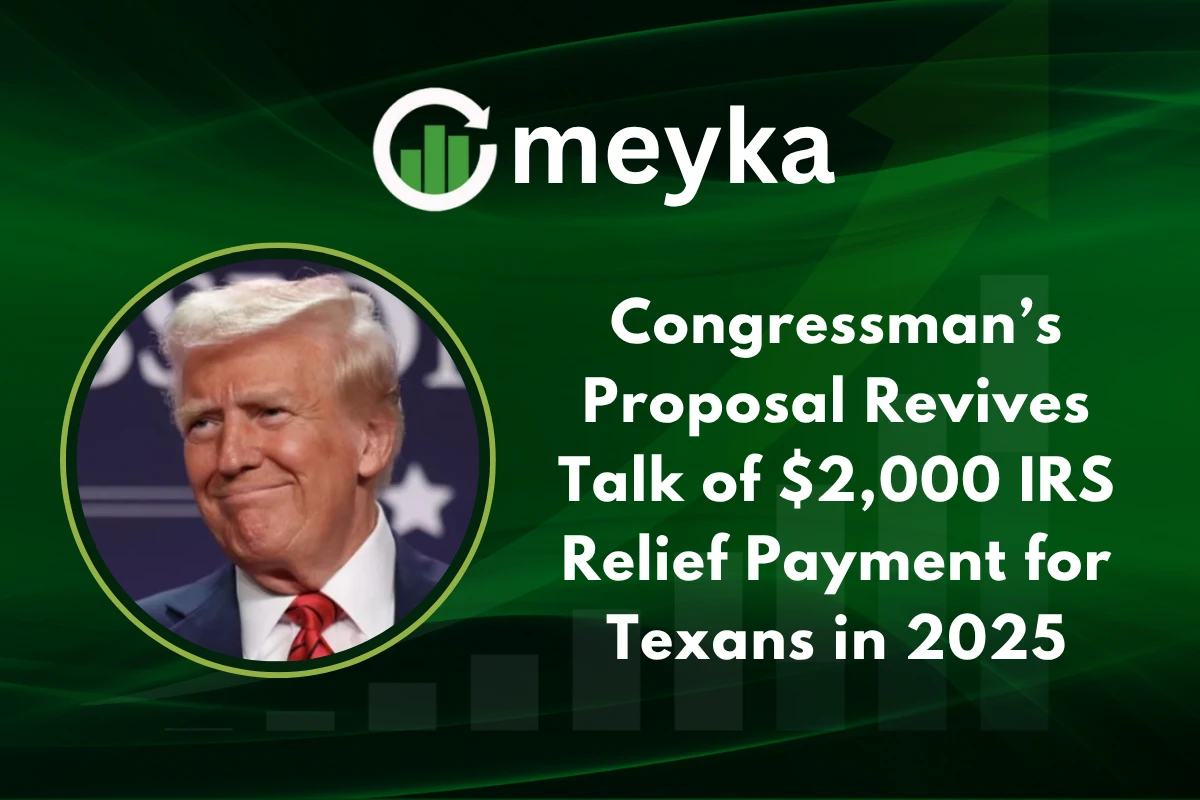Congressman’s Proposal Revives Talk of $2,000 IRS Relief Payment for Texans
A Texas congressman has put a fresh idea on the table, a proposal that has revived hope for a $2,000 IRS Relief Payment for eligible Texans in 2025. The plan moved quickly from committee rooms to social feeds, and it has pushed urgent questions about who qualifies, how the money would be paid, and whether Congress will approve a funding route.
Reporting notes the plan would use the IRS’s payment systems, delivering help by direct deposit for many households, and seeks to target Texans facing high living costs and disaster recovery expenses. Sources covering the developing story include Yahoo News, AtHomeCaregivers, and UIowa IFC Recruitment.
What Is the Proposed IRS Relief Payment for Texans?
The proposed IRS Relief Payment aims to deliver a one-time payment of $2,000 to eligible Texas residents. A congressman introduced the plan as a targeted relief measure, intended to help households hit by high prices and recent weather-related losses.
According to Yahoo News, the $2,000 figure is the headline amount under discussion, and the idea is to route the cash through IRS systems to reach taxpayers by direct deposit where possible.
Why now?
Lawmakers say Texas faces distinct pressures, including rising energy and housing costs, plus recovery needs after storms. The sponsor argues targeted help can be faster and more efficient than broader measures, and that the IRS already has the infrastructure to move funds quickly.
How Would the $2,000 IRS Relief Payment Work?
Under the proposal, the IRS Relief Payment would use the agency’s existing payment rails. The IRS would run eligibility checks against recent tax filings, then issue deposits to bank accounts on file. For people without bank accounts, the IRS could mail paper checks, but direct deposit would speed delivery and reduce costs.
Who qualifies for the IRS Relief Payment?
Eligibility details are not final. Early reporting suggests qualification would rely on 2024 tax filings, household income limits, and proof of Texas residency.
UIowa IFC Recruitment points out that the exact thresholds matter because they determine how many Texans receive the payment and the cost to the federal budget.
How is the payment delivered?
Direct deposit is the preferred method. The IRS has handled large-scale deposits before, and outlets note the agency’s experience could help avoid long delays, assuming Congress gives clear legal authorization and appropriate funding.
Congressman’s Proposal Gains Momentum for an IRS Relief Payment
The plan has drawn attention from committee staff and some members who are exploring funding options and legislative language. Reports show conversations about whether to label the payment as disaster relief, a targeted rebate, or a one-off stimulus.
AtHomeCaregivers has reported on committee interest and the types of fiscal offsets staffers are considering.
Public response and social signals
Social media has amplified the idea fast. Local news outlets and community groups shared reactions ranging from cautious hope to skepticism about politics and timing. The Austin Statesman captured local interest and commentary in a social post:
Community leaders want clarity, especially on who qualifies and when payments would land.
Why Texans Are Watching the IRS Relief Payment Closely
Many families in Texas are feeling persistent pressure from rising costs. A direct, one-time IRS Relief Payment of $2,000 could cover critical bills such as rent, medical expenses, or power costs after storms. Supporters say targeted help is efficient, while critics caution about the long-term fiscal impact.
Is this the same as a federal stimulus check?
No, this proposal is narrower. It targets Texans specifically, and though it uses IRS delivery systems similar to past checks, it differs from broad, nationwide stimulus rounds.
Political Reactions and Expert Insights on the IRS Relief Payment
Economists and policy analysts are split. Some see direct payments as a rapid boost to local spending and a safety net for struggling households. Others warn about the budgetary effects and possible inflationary pressures if payments are not carefully funded.
UIowa IFC Recruitment has highlighted the need for offset plans and strong program design to avoid fraud and delays.
Balanced expert view
Supporters frame the payment as urgent relief, while sceptics call for transparent funding and strict oversight. Experts recommend clear eligibility rules and sunset clauses to ensure the measure is one-time only.
Timeline for the IRS Relief Payment in 2025
The tentative schedule discussed in reports shows congressional review in early 2025. If lawmakers act quickly and provide funds, the IRS could prepare deposit files and begin transfers later in the year.
Some optimistic projections place payments as early as October 2025, but everything depends on legislative pace.
Will it actually happen?
Momentum exists, but the payment still requires congressional approval and budget clearance. Timelines may shift, and political negotiations could reshape the plan. Track committee votes and funding language for the clearest signals.
How the IRS Relief Payment Compares to Past Aid
Earlier stimulus payments during national emergencies were broader and went to millions nationwide. This IRS Relief Payment differs because it targets a single state, aiming to address regional needs rather than national economic policy.
Analysts compare it more to targeted disaster assistance than to universal stimulus. Lessons from prior rounds stress the importance of clear rules and good data matching.
Texans’ Reactions and Community Impact of the IRS Relief Payment
Across Texas, residents and small business owners have voiced mixed feelings. Many say $2,000 would make a real difference. Civic groups call for simple, transparent claims processes to ensure the funds reach those most in need.
Local voices
Families say the payment could cover rent, medical bills, or energy costs. Community leaders urge Congress to move fast while ensuring fair access.
Financial Analysts Warn About Broader Effects of the IRS Relief Payment
Economists caution that targeted payments can boost consumption short term, but may add to inflation if not paired with supply-side measures. Analysts suggest pairing cash relief with policies that ease costs and support local supply chains.
Fiscal balancing
Any plan needs clear funding offsets, strong transparency, and oversight to preserve fiscal credibility while delivering aid.
Social cue: National commentary captured mixed expert views and debate on timing, funding, and impact:
Conclusion
The IRS Relief Payment proposal offers hope to many Texans, but it also raises serious policy questions about funding, eligibility, and timing. If Congress acts, direct deposits could reach recipients in 2025, yet the outcome depends on negotiations, budget choices, and administrative readiness.
For now, the idea is a prominent proposal under active debate, closely watched by families, businesses, and lawmakers across Texas.
FAQ’S
The IRS Relief Payment is a government initiative that provides financial assistance to eligible taxpayers during economic hardships, disasters, or emergencies.
Eligibility usually depends on income level, tax filing status, and residency. The IRS automatically determines qualified individuals based on recent tax returns.
You can check your payment status using the “Get My Payment” tool on the IRS website, which provides real-time updates about your relief payment progress.
Most IRS Relief Payments are directly deposited into bank accounts within a few weeks of approval, but mailed checks may take longer to arrive.
No, IRS Relief Payments are typically not considered taxable income and do not need to be reported on your federal tax return.
Disclaimer
The above information is based on current market data, which is subject to change, and does not constitute financial advice. Always do your research.






